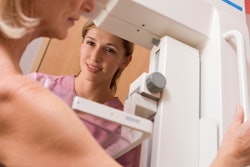
Breast cancer mortality dropped strongly from the 1990s onward in Switzerland, but is the decline due to mammography screening programs? The authors of a new study published on 14 March in BMJ Open say that's possible, but it could also be due to other factors such as advances in treatment.
Different regions of Switzerland adopted breast screening at different times, providing the opportunity to analyze whether declines in breast cancer mortality in a region corresponded to when it adopted screening -- and to compare that with other areas to fully assess screening's impact, according to a research team led by Christian Herrmann, PhD, head of statistics and evaluation at Cancer Registry St. Gallen-Appenzell, Cancer League Eastern Switzerland in St. Gallen, Switzerland.
They found that screening's impact on mortality was minimal.
"The influence of population-based mammography screening programs was small and could not be proven to be statistically significant," Herrmann told AuntMinnieEurope.com. "Several other factors contributed to the drop."
Declining mortality, but why?
A perennial controversy has raged around the effectiveness of breast cancer screening, despite the demonstrated decline in breast cancer mortality in countries that have implemented screening programs. Switzerland found itself in the center of the storm back in 2014, when an advisory group called the Swiss Medical Board said that it believed that breast cancer screening programs in the country should be discontinued.
Herrmann's study sprouts from this environment. He and his colleagues acknowledged that breast cancer mortality has declined considerably in the past decades in Switzerland, but the reasons for the decline remain controversial because of several factors -- including important advances in treatment approaches, breast cancer awareness, and the introduction of mammography screening programs in many European countries -- occurred almost simultaneously.
Switzerland offers a unique opportunity to study breast cancer screening, because the country consists of 26 relatively autonomous states called cantons, with each deciding whether to employ mammography screening. The cantons implemented breast cancer screening at different times over the past two decades. The first Swiss mammography pilot program was established in 1993 in the French-speaking canton of Vaud. However, the first organized program in the German-speaking canton of St. Gallen was only started in 2010.
Breast cancer mortality studies in Switzerland have shown contradictory results. Bulliard et al observed a steeper decrease from 1980 to 2002 in 55- to 74-year-olds in French-speaking regions where population-based mammography screening started earlier (Annals of Oncology, January 2006, Vol. 17:1, pp. 57-59). However, other studies show geographical differences were small, indicating perhaps mammography screening was not the cause.
In the present study, Herrmann and colleagues examined the topic further. They used data from the Swiss Federal Statistical Office on female breast cancer mortality, electronically available for the period of 1969 to 2012. They fitted statistical models on death rates indirectly standardized by national references and used linguistic region, degree of urbanization, duration of population-based screening programs, and socioeconomic index as covariates.
Breast cancer mortality slightly increased until 1989 to 1992 and declined strongly thereafter, they found. Until 2009 to 2012, the standardized mortality ratio declined to 57% of the 1969 to 1972 value. None of the other coefficients of the spatial regressions had a significant effect on breast cancer mortality. In 2009 to 2012, no region had significantly elevated or reduced breast cancer mortality at 95% credible interval level compared with the national mean.
Maybe not mammography
"Although significant spatial differences in breast cancer incidence are well-described for Switzerland, we have not found any significant differences in breast cancer mortality in any of the periods studied," the study authors wrote.
The researchers did not observe any general significant differences between regions classified by duration of screening programs, urbanization, language, and socioeconomic position. In addition, when limiting the analysis to the most recent period of 2009 to 2012, they found none of the factors was significant. Accordingly, the French language region, despite earlier implementation of mammography screening programs, did not show a relevant impact on breast cancer mortality in their study.
"The reasons for this are probably manifold and may include factors such as screen-detected cancers being mainly of low stage, many women having not participated in the screening programs, or having chosen to undergo opportunistic screening," the authors wrote. "In addition, the effect of advances in diagnosis and therapy on mortality is quite strong and may have outweighed benefits from population-based screening programs."
Also, the level of opportunistic screening in Switzerland has been described to be quite high, but data on the geographical differences in opportunistic screening use and, therefore, overall screening participation are not available.
"Continuous evaluation of geographical patterns of breast cancer mortality using modern spatiotemporal methodology is necessary for evaluating the efficacy of programs," they concluded.
Not everyone is in agreement with the results of the new study, one of them being breast cancer screening proponent Dr. Stephen Duffy from the Wolfson Institute of Preventive Medicine in London.
"This paper does not seem to me to give any conclusive result at all," he said. "As with many such analyses, time of diagnosis does not seem to be taken into account, as far as I can see. Thus, deaths in nominally screened populations will include cancers diagnosed before initiation of screening."
The areas with the longest screening experience have 14% lower rates of breast cancer mortality than the areas with the least experience, he added.
"And with all the potential misclassification due to time of diagnosis above, plus the potential for confounding in ecological analyses such as this, the true reduction may be greater," Duffy said.



















